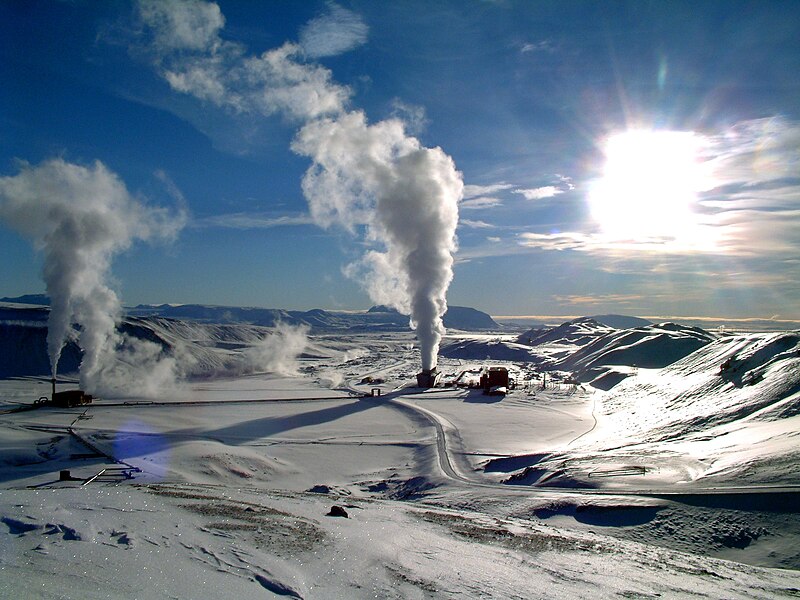Geothermal Power
Geothermal power harnesses the Earth's heat to generate electricity, providing a renewable and sustainable energy source. Advances in enhanced geothermal systems (EGS) have made large-scale power generation more feasible.

Krafla, a geothermal power station in Iceland
Image credit: Euractiv
View open jobs in this Solution
Example Companies
- Eavor - Eavor is a technology-based energy company that provides a clean, carbon-neutral, scalable, baseload power solution.
- AltaRock Energy - Develops enhanced geothermal systems (EGS) for efficient heat capture.
- Ormat Technologies - Specializes in geothermal and recovered energy generation.
- Davenport Newberry Holdings - Focuses on geothermal energy projects.
- Enel Green Power - Operates geothermal plants globally.
- Calpine Corporation - A leading producer of geothermal energy in the United States.
Overview
Geothermal power, a renewable energy source, taps into the Earth's core heat to generate electricity. Enhanced geothermal systems (EGS) involve injecting water into hot rock formations to create fractures, boosting energy extraction and making large-scale power generation feasible.
- Geothermal Energy: Using the heat beneath our feet - Climate Tech Distillery
Progress Made
Significant advancements have been made in geothermal power technologies:
- Enhanced Geothermal Systems (EGS): Involves injecting water into hot rock formations to create fractures, enhancing heat extraction.
- Commercial Geothermal Power Plants: Emerging worldwide, utilizing Earth's core heat for electricity generation.
- Direct Use Geothermal: Uses Earth's heat to warm buildings and structures, implemented in regions like the United States, Iceland, and New Zealand.
Solutions by Sector
Power Generation
- Geothermal Power Plants: Facilities that convert geothermal energy into electricity.
- Enhanced Geothermal Systems (EGS): Advanced technology to increase the efficiency of geothermal energy extraction.
- Hybrid Systems: Combining geothermal with other renewable energy sources for enhanced efficiency.
Case Studies:
- AltaRock Energy, USA: Develops EGS technology for efficient geothermal energy extraction (AltaRock Energy).
- Ormat Technologies, Global: Operates geothermal power plants worldwide, specializing in recovered energy generation (Ormat Technologies).
- Enel Green Power, Italy: Manages geothermal plants globally, integrating renewable energy sources (Enel Green Power).
Direct Use Applications
- District Heating: Using geothermal energy to heat multiple buildings through a centralized system.
- Greenhouse Heating: Utilizing geothermal heat for agricultural purposes.
- Industrial Processes: Applying geothermal energy for various industrial heating needs.
Case Studies:
- Reykjavik Geothermal District Heating, Iceland: Uses geothermal energy to heat the city (Orkuveita Reykjavíkur).
- Klamath Falls Geothermal District Heating, USA: Provides geothermal heating to the community (City of Klamath Falls).
- New Zealand Geothermal Greenhouses: Uses geothermal heat for agricultural production (GNS Science).
Policy and Advocacy
- Government Incentives: Providing financial incentives for geothermal energy projects.
- Regulatory Support: Implementing policies to promote geothermal energy adoption.
- International Collaboration: Working with global organizations to enhance geothermal energy development.
Case Studies:
- U.S. Department of Energy (DOE): Supports geothermal research and development (DOE).
- International Renewable Energy Agency (IRENA): Promotes global adoption of geothermal energy (IRENA).
- Geothermal Energy Association (GEA): Advocates for geothermal energy policies and incentives (GEA).
Lessons Learned
- Efficiency: Geothermal power is a clean, efficient, and environmentally friendly energy source.
- Technology Development: Continued research and development are crucial for enhancing geothermal power technologies.
- Economic Incentives: Providing economic incentives encourages investment in geothermal energy.
- Collaboration: Collaborative efforts among government, industry, and NGOs are essential for successful geothermal projects.
- Adaptability: Geothermal energy strategies must be adaptable to different geological conditions.
Challenges Ahead
- High Upfront Cost: Expensive drilling and infrastructure development for geothermal energy extraction.
- Resource Variability: Inconsistent temperature and water availability in the Earth's crust.
- Environmental Impact: Potential air and noise pollution, groundwater contamination, and seismic activities from drilling.
- Public Awareness: Increasing public awareness about the benefits of geothermal energy.
Best Path Forward
- Research and Development: Invest in technology enhancement and cost reduction.
- Policy and Incentives: Establish measures to encourage large-scale adoption of geothermal energy.
- International Collaboration: Work with global organizations to share knowledge and best practices.
- Public Awareness: Educate the public about the benefits of geothermal energy.
- Sustainable Practices: Ensure sustainable and environmentally friendly practices in geothermal energy projects.
Direct-Use Heat Analysis
Facilities with units serviceable by direct-use geothermal heat based on data from EPA Greenhouse Gas Reporting Program (GHGRP), EIA MECS, and estimated subsurface temperature gradients. Markers are colored by estimated breakeven price (USD/MMBTU).
Contact softwareengineerprogrammer on GitHub for further information.
Image credit: Euractiv